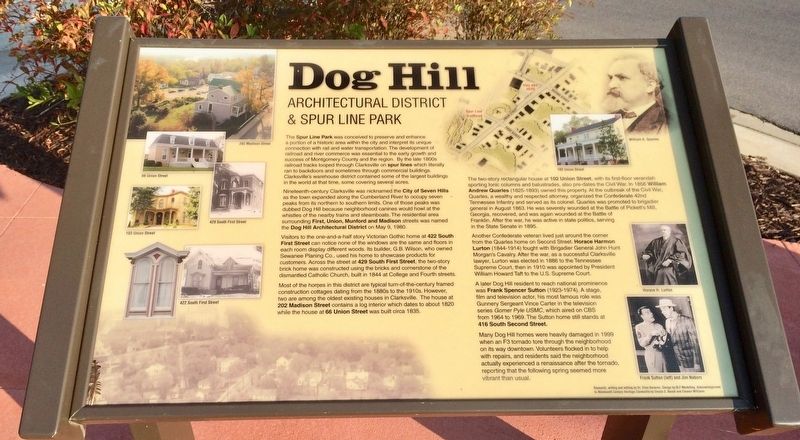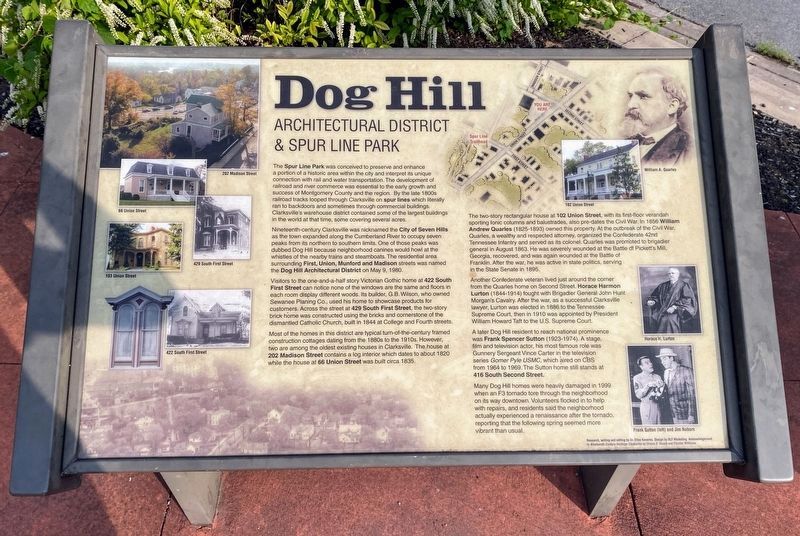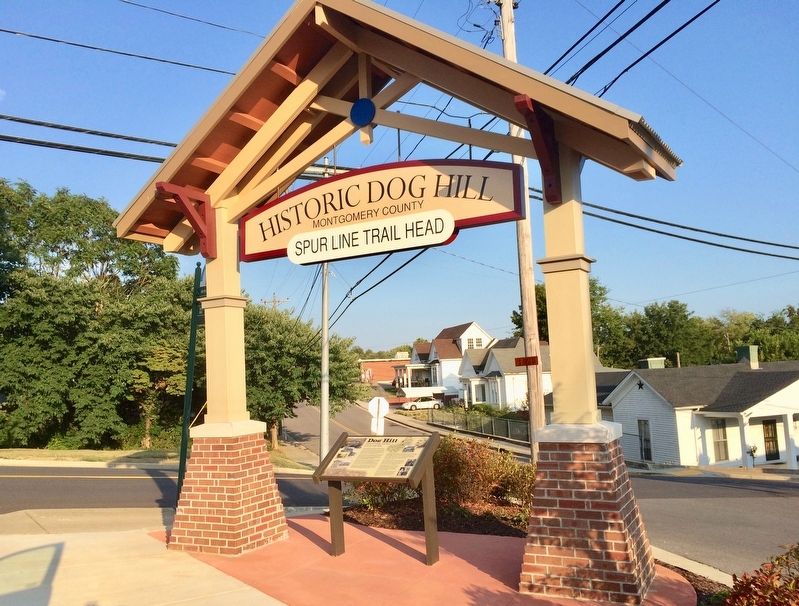Clarksville in Montgomery County, Tennessee — The American South (East South Central)
Dog Hill
Architectural District & Spur Line Park
Nineteenth-century Clarksville was nicknamed the City of Seven Hills as the town expanded along the Cumberland River to occupy seven peaks from its northern to southern limits. One of those peaks was dubbed Dog Hill because neighborhood canines would howl at the whistles of the nearby trains and steamboats. The residential area surrounding First, Union, Munford and Madison streets was named the Dog Hill Architectural District on May 9, 1980.
Visitors to the one-and-a-half story Victorian Gothic home at 422 South First Street can notice none of the windows are the same and floors in each room display different woods. Its builder, G.B. Wilson, who owned Sewanee Planing Co., used his home to showcase products for customers. Across the street at 429 South First Street, the two-story brick home was constructed using the bricks and cornerstone of the dismantled Catholic Church, built in 1844 at College and Fourth streets.
Most of the homes in this district are typical turn-of-the-century framed construction cottages dating from the 1880s to the 1910s. However two are among the oldest existing houses in Clarksville. The house at 202 Madison Street contains a log interior which dates to about 1820 while the house at 66 Union Street was built circa 1835.
The two-story rectangular house at 102 Union Street, with its first-floor verandah sporting Ionic columns and balustrades, also pre-dates the Civil War. In 1856 William Andrew Quarles (1825-1893) owned this property. At the outbreak of the Civil War, Quarles, a wealthy and respected attorney, organized the Confederate 42nd Tennessee Infantry and served as its colonel. Quarles was promoted to brigadier general in August 1863. He was severely wounded at the Battle of Pickett's Mill, Georgia, recovered, and was again wounded at the Battle of Franklin. After the war, he was active in state politics, serving in the State Senate in 1895.
Another Confederate veteran lived just around the corner from the Quarles home on Second Street. Horace Harmon Lurton (1844-1914) fought with Brigadier General John Hunt Morgan's Cavalry. After the war, as a successful Clarksville lawyer, Lurton was elected in 1886 to the Tennessee Supreme Court, then in 1910 was appointed by President William Howard Taft to the U.S. Supreme Court.
A later Dog Hill resident to reach national prominence was Frank Spencer Sutton (1923-1974). A stage, film and television actor, his most famous role was Gunnery Sergeant Vince Carter in the television series Gomer Pyle USMC, which aired on CBS from 1964 to 1969. The Sutton home still stands at 416 South Second Street.
Many Dog Hill homes were heavily damaged in 1999 when an F3 tornado tore through the neighborhood on its way downtown. Volunteers flocked in to help with repairs, and residents said the neighborhood actually experienced a renaissance after the tornado, reporting that the following spring seemed more vibrant than usual.
Topics and series. This historical marker is listed in these topic lists: Architecture • Parks & Recreational Areas. In addition, it is included in the Former U.S. Presidents: #27 William Howard Taft series list. A significant historical date for this entry is May 9, 1980.
Location. 36° 31.479′ N, 87° 21.472′ W. Marker is in Clarksville, Tennessee, in Montgomery County. Marker is at the intersection of South 2nd Street and Union Street, on the right when traveling south on South 2nd Street. Located in the parking lot of the law offices of Cunningham Mitchell & Rocconi. Touch for map. Marker is at or near this postal address: 398 South 2nd Street, Clarksville TN 37040, United States of America. Touch for directions.
Other nearby markers. At least 8 other markers are within walking distance of this marker. Horace H. Lurton (about 300 feet away, measured in a direct line); In Memory of Colonel Valentine Sevier (about 300 feet away); Clarksville Federal Building (about 600 feet away); Clarksville Federal Building/Post Office/Customs House (about 600 feet away); Pioneer Newspaper (about 600 feet away); Madison Street Methodist Church (about 700 feet away); Montgomery County Courthouse (about 700 feet away); Austin Peay (about 700 feet away). Touch for a list and map of all markers in Clarksville.
Also see . . . Dog Hill Architectural District. (Submitted on September 4, 2018, by Mark Hilton of Montgomery, Alabama.)
Credits. This page was last revised on June 6, 2021. It was originally submitted on September 4, 2018, by Mark Hilton of Montgomery, Alabama. This page has been viewed 1,068 times since then and 201 times this year. Photos: 1. submitted on September 4, 2018, by Mark Hilton of Montgomery, Alabama. 2. submitted on June 3, 2021, by Shane Oliver of Richmond, Virginia. 3. submitted on September 4, 2018, by Mark Hilton of Montgomery, Alabama.


